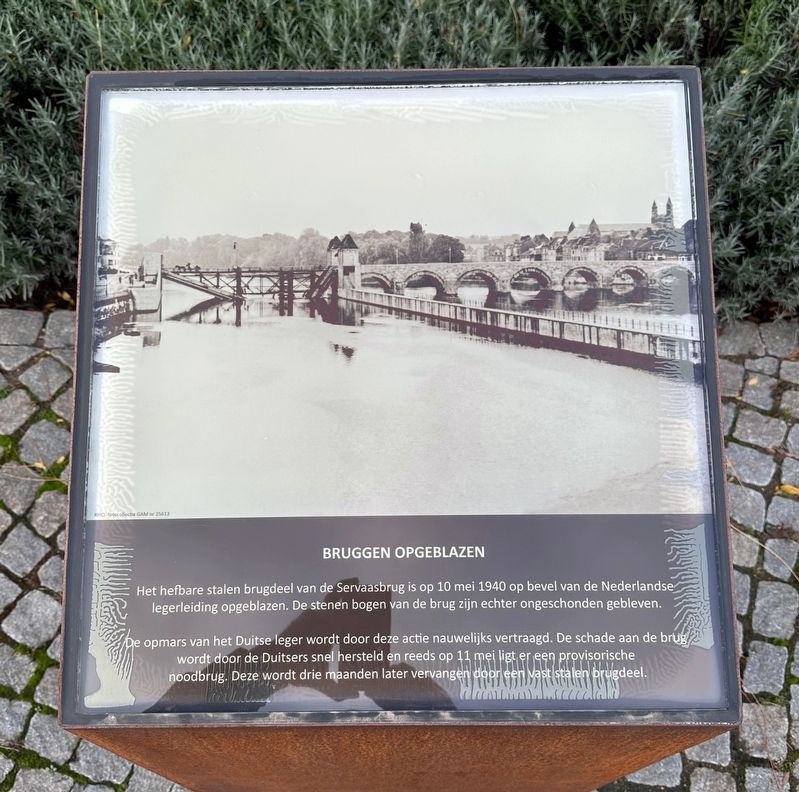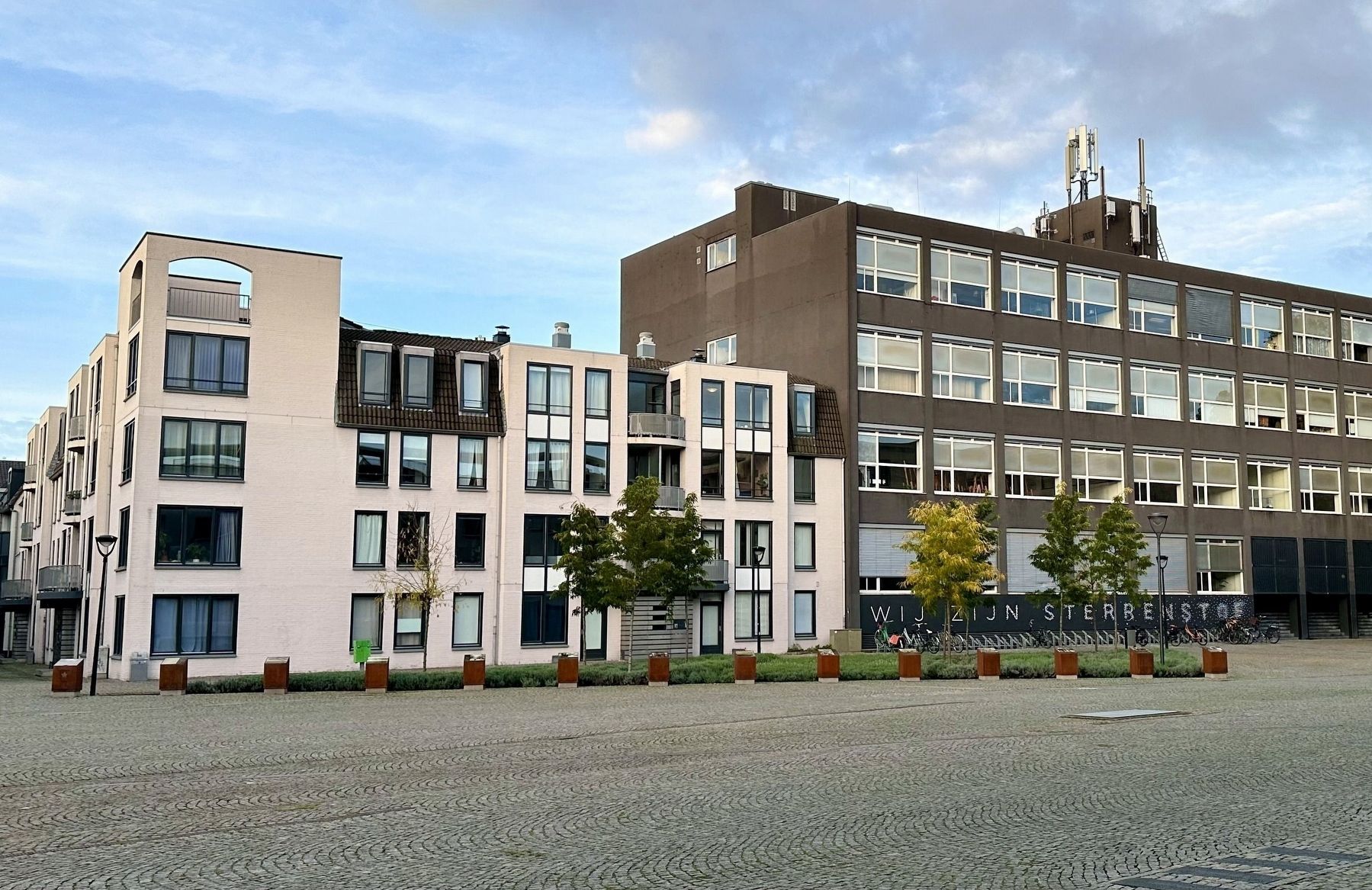Kommelkwartier in Maastricht, Limburg, Netherlands — Northwestern Europe
Herdenkingsplein (04): Bruggen Opgeblazen / Blown up Bridges
Inscription.
Het hefbare stalen brugdeel van de Servaasbrug is op 10 mei 1940 op bevel van de Nederlandse legerleiding opgeblazen. De stenen bogen van de brug zijn echter ongeschonden gebleven.
De opmars van het Duitse leger wordt door deze actie nauwelijks vertraagd. De schade aan de brug wordt door de Duitsers snel hersteld en reeds op 11 mei ligt er een provisorische noodbrug. Deze wordt drie maanden later vervangen door een vast stalen brugdeel.
Blown up Bridges
The liftable steel bridge section of the Servaas Bridge was blown up on May 10, 1940 on the orders of the Dutch army leadership. However, the stone arches of the bridge remained intact.
The advance of the German army was hardly slowed down by this action. The damage to the bridge was quickly repaired by the Germans and a temporary emergency bridge was installed on May 11. This was replaced three months later by a fixed steel bridge section.
Erected 2022.
Topics. This memorial is listed in these topic lists: Bridges & Viaducts • War, World II. A significant historical date for this entry is May 10, 1940.
Location. 50° 50.935′ N, 5° 40.927′ E. Marker is in Maastricht, Limburg. It is in Kommelkwartier. Memorial is on Herdenkingsplein, on the right when traveling west. Touch for map. Marker is in this post office area: Maastricht, Limburg 6211 PW, Netherlands. Touch for directions.
Other nearby markers. At least 8 other markers are within walking distance of this marker. Herdenkingsplein (05): Hakenkruizen in de Grote Staat / Swastikas over the Grote Staat (here, next to this marker); Herdenkingsplein (03): Duitse Colonnes / German Convoy (here, next to this marker); Herdenkingsplein (06): Persoonsregistratie / Personal Registration (here, next to this marker); Herdenkingsplein (02): Dagsboekfragment / Diary Excerpt (here, next to this marker); Herdenkingsplein (07): Schuilgelegenheid / Shelter (here, next to this marker); Herdenkingsplein (01): Zo Tot Veer Noets Vergete / So That We Do Not Forget (here, next to this marker); Herdenkingsplein (08): ‘Op de Bon’ / Food Coupons (a few steps from this marker); Herdenkingsplein (09): Arbeidsbureau Batterijstraat / Batterijstraat Employment Office (a few steps from this marker). Touch for a list and map of all markers in Maastricht.
Also see . . . Maastricht (War Over Holland). An account of the Battle of Maastricht in 1940
Excerpt(Submitted on February 11, 2024.)on the fighting for the bridges onthe morning of May 10, 1940: The beautiful, ancient St.Servaesbrug - the taking of which the BtlzbV100 and the 4th Tank Division were aiming for - was blown up at 0600 hours, when the first armoured cars appeared in sight. Fifteen minutes later the Wilhelminabrug followed. The persistent German endeavours to seize these two important objectives intact had been in vain ...
The last object that the Germans wanted to seize in good working order was the railway bridge. With some timber modifications this would also be useful as a crossing point for tanks. A platoon of around 35 men defended this object, supported by one heavy machinegun, three light machineguns and two 2 cm anti-tank rifles. From the north they were confronted with the remainders of the Sonderverband Hocke [one remembers that these men found a hole in the defences at the sluice-complex at Borgharen]. The head of the column of cars and motorbikes was shot up by the Dutch anti-tank rifles and heavy machinegun. Especially the anti-tank rifles proved very effective in this engagement. The Germans jumped out of their cars and off their bikes and took shelter in a factory. Soon they tried to work their way forward towards the capital bridge. The Dutch defenders all evacuated to the westbank of the river and closed the iron gates across the track. The first Germans - accompanied by their leading officer Leutnant Hocke - climbed over the gates. Some fell from Dutch fire; others were able to reach the bridge. At that moment the burning fuse had reached the charges. The bridge sections sank into the river [0620 hours], taking a few of the Germans with them - including the Leutnant.
After the Maas bridges had been destroyed the remaining Dutch forces behind the Maas had only one task that remained: to withhold the enemy from crossing the Maas as long as possible.
Credits. This page was last revised on February 28, 2024. It was originally submitted on February 11, 2024, by Andrew Ruppenstein of Lamorinda, California. This page has been viewed 51 times since then. Photos: 1, 2. submitted on February 11, 2024, by Andrew Ruppenstein of Lamorinda, California.

